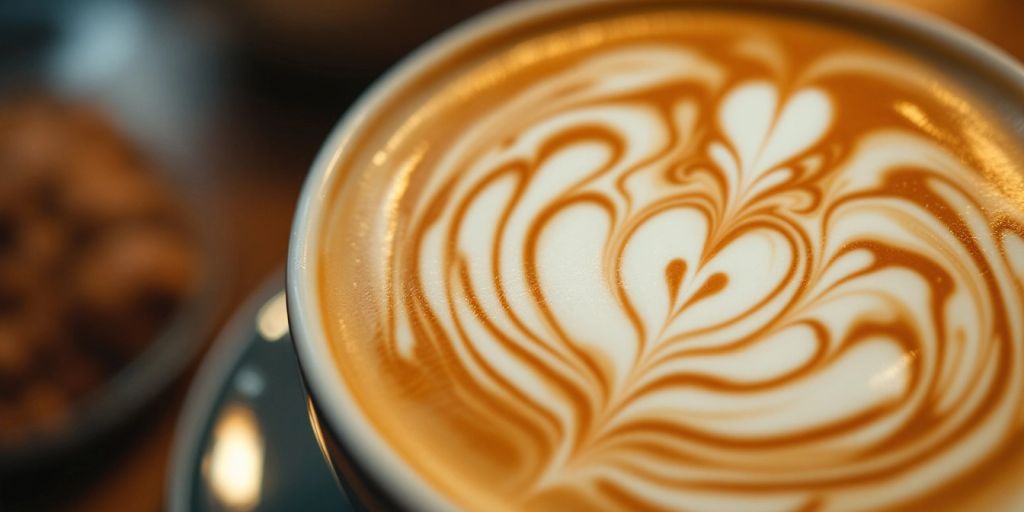Latte art is more than just a fun addition to your coffee; it’s a skill that can turn a simple drink into a beautiful creation. Whether you’re a barista or someone who enjoys coffee at home, understanding how to create stunning designs can enhance your coffee experience. In this article, we will explore essential tools, techniques, and tips to help you master the art of latte making. From preparing your espresso to troubleshooting common issues, this guide will provide everything you need to know to impress your friends and family with your latte art skills.
Key Takeaways
- Start with quality tools like a good espresso machine and frothing pitcher.
- Practice steaming milk to get the right texture for pouring.
- Learn basic pouring techniques to create simple designs like hearts and tulips.
- Experiment with advanced techniques for more intricate designs.
- Troubleshoot common problems to improve your latte art skills.
Essential Tools for Latte Art
Creating stunning latte art starts with the right tools. Here’s what you need to get started:
Espresso Machine and Grinder
A high-quality espresso machine is essential for crafting the perfect base for your latte art. Look for one with a steam wand to create that creamy milk foam. If you don’t have an espresso machine, consider a handheld alternative like the NanoFoamer.
Milk Frothing Pitcher
A stainless steel milk pitcher is a must-have. Choose one with a pointed spout for better control when pouring. This will help you create those intricate designs that wow your friends!
Thermometer and Scale
Using a thermometer ensures your milk is at the right temperature, usually around 150°F (65°C). A scale can help you measure your coffee grounds accurately, ensuring a consistent brew every time.
Latte Art Pens and Etching Tools
While you can use everyday items like skewers for etching, having dedicated latte art pens can elevate your designs. Experiment with different tools to find what works best for you!
With these essential tools, you’ll be well on your way to creating beautiful latte art that impresses everyone!
The Perfect Canvas: Preparing Your Espresso and Milk
Pulling the Perfect Espresso Shot
To create stunning latte art, you need a solid base: espresso. A well-pulled shot is crucial! Aim for a rich, creamy layer of crema on top. Here’s how to do it:
- Use fresh, high-quality coffee beans.
- Grind your beans just before brewing for maximum flavor.
- Tamp the grounds evenly in the portafilter.
- Brew at the right temperature (around 190-205°F).
Steaming Milk to Perfection
Steaming milk is an art in itself. You want it to be velvety and smooth. Here’s how:
- Fill your pitcher about one-third full with cold milk.
- Submerge the steam wand just below the surface.
- Create a whirlpool effect to incorporate air.
- Stop steaming when the milk reaches about 150°F.
Achieving the Right Milk Texture
The texture of your milk can make or break your latte art. Aim for a microfoam that’s glossy and smooth. Here are some tips:
- Use whole milk for a creamier texture.
- Avoid reheating leftover milk; always use fresh.
- Practice your steaming technique to get that perfect foam.
Common Mistakes and How to Avoid Them
Even the best baristas make mistakes. Here’s how to troubleshoot:
- Milk Separation: Ensure you’re steaming correctly to avoid large bubbles.
- Inconsistent Patterns: Practice your pouring technique to maintain control.
- Wrong Temperature: Always check your milk temperature to avoid scalding.
Mastering the art of preparing espresso and milk is essential for creating beautiful latte art. With practice, you’ll be able to impress everyone with your skills!
Basic Pouring Techniques for Beginners
Creating beautiful latte art starts with mastering some basic pouring techniques. Here are a few essential methods to get you started:
The Heart Design
To create a heart, begin by pouring slowly into the center of your cup. Finish with a gentle ‘strike-through’ motion to form the heart shape. This technique is all about control and precision.
The Rosetta Pattern
For the rosetta, start with a steady pour and then gently shake the pitcher side to side as you move it back and forth. This will create the layered lines that resemble leaves. Remember, practice makes perfect!
The Tulip Design
The tulip is a fun design that involves stacking dots. Start by pouring a dot, then lift the pitcher and pull through to create the tulip shape. It’s all about layering and flow.
Tips for Consistent Pours
- Practice regularly to build muscle memory.
- Use a clean pitcher to ensure the best texture.
- Pay attention to the speed and angle of your pour.
Mastering these basic techniques will set the foundation for your latte art journey. With time and practice, you’ll be able to create stunning designs that impress everyone!
Advanced Latte Art Techniques

Creating a Swan Design
The swan design is a beautiful and intricate pattern that showcases your skills. Start by pouring a heart shape as the base, then add a gentle twist to form the swan’s neck and wings. This design requires practice, but the results are stunning!
Mastering the Wave Heart
This technique adds a fun twist to the classic heart. Begin with a standard heart shape, then use a barista tool or a toothpick to draw through the foam, creating a wavy effect. The result is a unique heart that stands out!
Experimenting with Free Pour and Etching
Free pouring allows for creativity and spontaneity. Try pouring different shapes without a template. For more detailed designs, use etching tools to add intricate details. Experimentation is key to finding your style!
Using Different Pitcher Spouts
Different pitcher spouts can change your pouring technique. A pointed spout allows for precision, while a wider spout can create larger designs. Choose the right spout for your desired effect!
Mastering advanced latte art techniques takes time and patience, but the joy of creating beautiful designs is worth the effort. Keep practicing and let your creativity flow!
Troubleshooting Your Latte Art

Creating beautiful latte art can sometimes feel like a challenge. But don’t worry! Here are some common issues and how to fix them.
Fixing Milk Separation Issues
- Pour immediately after steaming to keep the foam and liquid mixed.
- If you notice separation, try transferring the milk to another jug to remix.
- Avoid letting milk sit too long before pouring.
Dealing with Inconsistent Patterns
- Check your pouring technique. Pouring too high or too slow can blur your designs.
- Aim for a moderate height and steady speed while pouring.
- Practice makes perfect! Keep experimenting with different angles and speeds.
Adjusting Milk Temperature and Foam
- The ideal milk temperature is between 140-150°F (60-65°C). Too hot or too cold can ruin your texture.
- Ensure your milk is well-frothed with a velvety consistency. Large bubbles can mess up your designs.
- Practice your steaming techniques to achieve that perfect microfoam.
Common Pouring Mistakes and Solutions
- Too much foam: Adjust your steaming time to create a smoother texture.
- Too little foam: Make sure to inject air while steaming to create microfoam.
- Faint designs: Pour faster to allow the milk to sit on top of the espresso.
Remember, every mistake is a chance to learn! Keep practicing, and soon you’ll be creating stunning latte art that impresses everyone.
Embrace the journey of mastering your latte art skills, and don’t forget to explore the coffee roastery for more tips and inspiration!
Beyond Coffee: Latte Art in Other Beverages
Latte art isn’t just for coffee anymore! Get creative with your drinks by adding stunning designs to other beverages like hot chocolate and matcha lattes. These alternative canvases not only look amazing but also bring a new flavor experience to your table.
Latte Art with Hot Chocolate
- Use a rich, creamy hot chocolate as your base.
- Froth milk to create a velvety texture.
- Pour designs like hearts or swirls to elevate your drink.
Creating Designs in Matcha Lattes
- Whisk matcha powder with hot water for a smooth base.
- Steam milk to a silky foam.
- Pour carefully to create beautiful patterns that contrast with the green matcha.
Using Alternative Milks for Latte Art
- Experiment with oat, almond, or soy milk for unique flavors.
- Each milk has different frothing properties, so adjust your technique accordingly.
- Practice makes perfect; find the right milk for your designs.
Exploring Cold Brew and Nitro Coffee Art
- Cold brew can be a refreshing canvas for art.
- Use a frothing tool to create foam on top.
- Nitro coffee adds a creamy texture that’s perfect for intricate designs.
Latte art is all about exploration and creativity. Don’t be afraid to try new things and make your drinks visually stunning!
Latte art isn’t just for coffee anymore! You can find beautiful designs in other drinks too, like hot chocolate and matcha lattes. These creative patterns make your beverages look amazing and taste even better. Want to learn more about this fun trend? Visit our website for tips and inspiration!
Final Thoughts on Latte Art
In conclusion, mastering latte art is a fun and rewarding journey that can enhance your coffee experience. With the right tools, practice, and a bit of patience, anyone can create beautiful designs that impress friends and family. Remember, it’s all about enjoying the process and learning from your mistakes. So grab your milk pitcher, experiment with different techniques, and let your creativity flow. Soon enough, you’ll be serving up lattes that are not just tasty but also visually stunning!
Frequently Asked Questions
What tools do I need to start making latte art?
To begin your latte art journey, you’ll need an espresso machine, a milk frothing pitcher, a thermometer, and possibly some latte art pens for detailed designs.
How do I prepare the milk for latte art?
You’ll want to steam your milk until it reaches about 140-150°F, creating a silky microfoam with tiny bubbles for the best texture.
What is the easiest latte art design for beginners?
The heart design is a great starting point. It involves pouring milk into the center of the espresso and gently shaking back and forth to form the shape.
How can I fix common latte art mistakes?
If your designs are not coming out right, check the milk texture and temperature. Practice pouring techniques and adjust your speed and angle.
Can I make latte art with non-dairy milk?
Yes! You can use non-dairy options like almond, soy, or oat milk, but make sure to choose brands that froth well for the best results.
Where can I learn more about latte art techniques?
There are many online resources, including tutorials, videos, and coffee courses that can help you improve your latte art skills.



